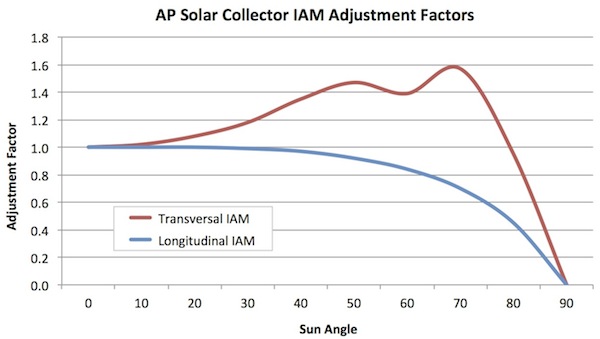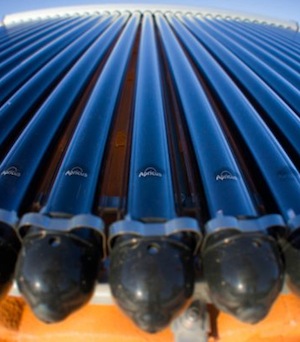Feb 19th, 2018
Nov 12th, 2015
Solar Collector Efficiency
Defining Collector Efficiency
Solar hot water collectors are tested by third party laboratories in order to obtain product certifications such as Australia Standards (AS/NZS 2712), SRCC OG100 and Solarkeymark. The testing provides a set of performance variables for each solar collector that can be used to determine the heat output under a set of given environmental and operating conditions.
These values can be used in a formula to calculate an instantaneous heat output value. That, however, isn't particularly useful to the average end user, as it is only a snapshot of performance, and not total annual output. To obtain a more accurate estimate of energy over a full year, complex modeling software is required. For large scale commercial projects, Apricus uses modeling software to complete forecasts of expected energy output and savings.
For a simple residential applications, such complex modeling is simply not required, with basic rule of thumb sizing sufficient, as provided here.

Collector Surface Area
Solar collector performance variables can be used to promote the "performance" of a solar collector, in particular the peak efficiency value is used. A value of 60-80% is common for most thermal solar collectors, but this value needs to be taken with a grain of salt, with the surface area it is based on considered.
There are three different surface areas that may be used to define the size of a thermal solar collector: Gross, Aperture & Absorber.
Gross Area
Calculated as the total width x height.
This measure therefore can include the frame, manifold casing, and in the case of evacuated tube collectors even the spaces between the tubes. It is a good value to look at when considering if a solar collector will fit on a roof, but not really useful for comparing efficiency.
Aperture Area
- Flat Plate Collectors: Calculated as the area of the glazing (glass) exposed to sunlight.
- Evacuated Tube Collectors: Calculated as the inner diameter of the clear glass tube.
Aperture has been adopted by most countries and industry associations as the standard surface area to use when quoting efficiency values
Absorber Area
- Flat Plate Collectors: Calculated as the exposed area of the solar absorber.
- Evacuated Tube Collector: Calculated as the diameter of the round absorber, or flat area of the absorber for evacuated tubes with absorber fins inside.
Note that Aperture, Absorber and Gross measurements may differ between test labs and countries based on their definitions. Eg. Solarkeymark and SRCC are different.
Efficiency Comparisons
As stated above, Aperture is the most widely accepted surface area to use when looking at performance variables. This is very important, as using the wrong type of surface area greatly effects the values.
Example:
The "peak efficiency" value for an AP solar collector is 68.7% based on Aperture area of 2.83m2. If based on gross area of 4.4m2, this value is only 43.7%.
A flat plate collector may have a performance value of 75% based on aperture area, but because the gross area is almost the same as aperture, the gross value will only be slightly lower. So comparing a flat plate collector's gross area to the gross area of an evacuated tube collector provides very misleading results.
Sun Angle (IAM)
Depending on the design of the collector, the output may change as the angle between the collector and the sun changes. This is referred to as Incidence Angle Modifier (IAM). A more layman friendly term to use is the Sun Angle Factor. Flat plate collectors generally all have the same curves, but evacuated tube collectors and those with reflectors can have very different curves throughout the day. For this reason it is important to understand and consider the Sun Angle Factor for collectors when doing a comparison.
The two types of IAMs are as follows:
- Transversal IAM measures the change in performance as the angle of the sun in relation to the collector changes through the DAY.
- Longitudinal IAM measures the change in performance as the angle of the sun in relation to the collector changes through the YEAR.

Below are examples of IAM curves for the average flat plate collector, and then the Apricus AP evacuated tube collector.

For flat plate collectors, both the longitudinal and transversal curves follow the same path, which is close to a cosine curve. As the angle of the sun passes the 45o point the amount of light the collector receives rapidly drop, reaching zero at 90o.

The graph shown above is for the Apricus AP evacuated tube solar collector. For such evacuated tubes collectors that have the tubes installed in the vertical orientation (up-down, not left-right) the longitudinal curve is virtually the same as a flat plate. The transversal curve, however, differs greatly, with the actual shape of the curve depending greatly on the spacing of the evacuated tubes and if a reflective panel is present or not. The IAM angle factors can be multiplied by an energy output calculation (outlined earlier) to obtain the actual output from the collector at a certain time of the day. Below are the raw values for each angle which are required if doing solar collector output calculations.
| 0o | 10o | 20o | 30o | 40o | 50o | 60o | 70o | 80o | 90o | |
| Longitudinal | 1.00 | 1.00 | 1.00 | 0.99 | 0.97 | 0.92 | 0.84 | 0.70 | 0.45 | 0.00 |
| Transversal | 1.00 | 1.02 | 1.08 | 1.18 | 1.35 | 1.47 | 1.39 | 1.57 | 0.95 | 1.00 |
The shape of the transversal IAM curve is linked to the round shape of the evacuated tubes and the space between the tubes that allow light through at midday.
![]()
Due to the 360o absorber surface, Apricus evacuated tubes Passively Track the sun throughout the day, as the round absorber is facing the sun from 7am to 5pm. This is a key advantage over flat plate collectors than only have maximum sun exposure (angle factor = 1) at midday.
 Passive tracking of Apricus AP evacuated tube solar collectors and the resultant Sun Angle Factor adjustment is required to get true output values. Ignoring this and just comparing to another collector based on the performance variables would not provide accurate real life output values. Modeling software packages such as Polysun (used by Apricus) take into full consideration both the longitudinal and transversal IAM factors to provide a very accurate output model for a system over a typical full year of operation.
Passive tracking of Apricus AP evacuated tube solar collectors and the resultant Sun Angle Factor adjustment is required to get true output values. Ignoring this and just comparing to another collector based on the performance variables would not provide accurate real life output values. Modeling software packages such as Polysun (used by Apricus) take into full consideration both the longitudinal and transversal IAM factors to provide a very accurate output model for a system over a typical full year of operation.
If you have project that requires a detailed calculation using Polysun, please contact us. This is one of the Project Support services that Apricus offers.
More detailed information about solar collector efficiency is also presented in the Apricus Tech Centre (requires login). Click here if you wish to apply for access.














